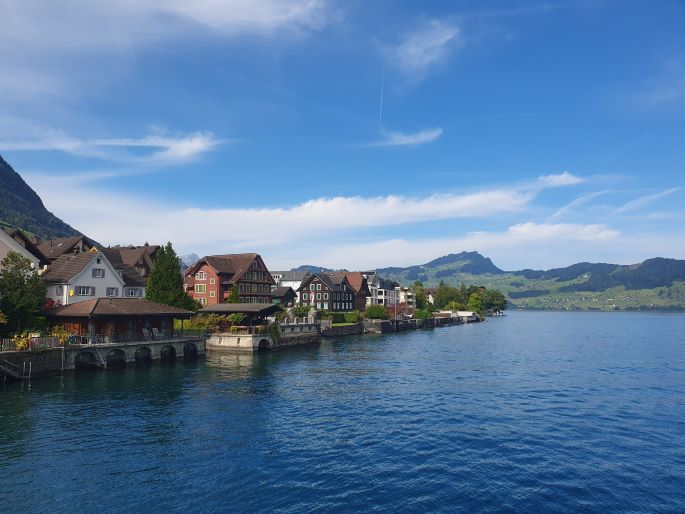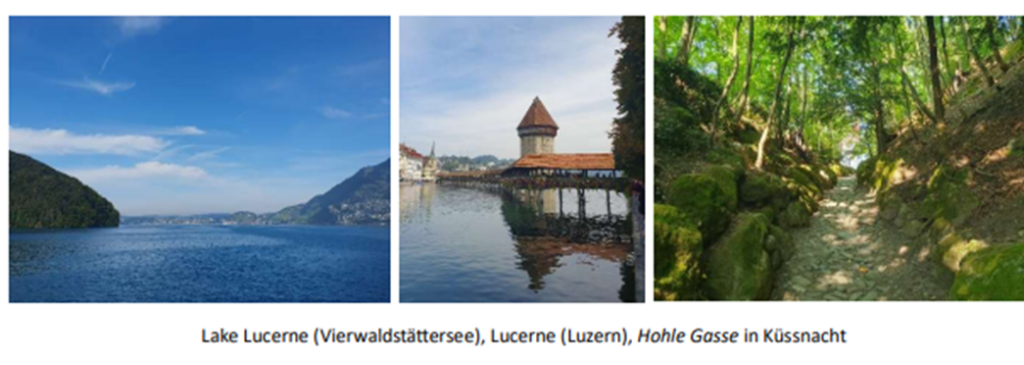Beyond Borders: My ERASMUS Experience in Steinen, Switzerland (Canton of Schwyz)
My name is Petra Mayer, and I recently returned from a two-week Erasmus internship at a
primary school in Steinen, located in the Canton of Schwyz, Switzerland. During this time, I had
the opportunity to work with a lively and lovely class of 18 third-grade students under the
guidance of an experienced and highly organised teacher, whose sense of humour added
greatly to the classroom atmosphere. In addition to observing the daily routines of the class, I
was also able to accompany the special education teachers, gaining valuable insights into
inclusive education, which is a key focus of my studies.

The picture is taken by Petra

The picture is taken by Petra
Steinen, located in the Canton of Schwyz, is a picturesque village that combines natural beauty
with a strong sense of community. The region is known for its proximity to cultural and
historical landmarks, such as the Swiss NaƟonal Museum in Zurich and the History Forum
Museum in Schwyz, offering visitors an enriching insight into Swiss history. Steinen is also just
a short distance from Lake Lucerne (VierwaldstäƩersee), one of Switzerland’s most scenic
locations, where I was able to enjoy a boat trip from Brunnen to Lucerne. The village is
surrounded by mountains, making it an ideal starting point for hiking, including a memorable
trek up Hochstuckli Mountain with my class during a school outing. Nearby Küssnacht, which
I also visited, offering the historic “Hohle Gasse”, famously connected to the William Tell
legend. Steinen itself is known for its warm, close-knit community, where residents greet each
other with a friendly “Grüezi” and extend their hospitality to visitors. Public transport operates
seamlessly, supported by a user-friendly app, making it easy to explore the region. This
welcoming atmosphere extends to the local primary school, where I had the opportunity to
observe and participate in the daily activities, as detailed in the next secton.

The pictures are taken by Petra
The Swiss school system reflects the country’s federalist structure, with each canton having
autonomy over its educational policies. While national guidelines exist, the specifics of
curricula, school organisation and languages of instruction vary by region. In Canton Schwyz,
the system follows the general Swiss model, which is divided into three main stages: primary
education, secondary education, and tertiary education. Primary education begins at the age
of six and lasts for six years, focusing on key subjects such as mathematics, reading, writing,
social and natural sciences and languages. In the later years of primary school, English and
French are introduced, reflecting Switzerland’s commitment to multilingualism. The system
places strong emphasis on individual learning needs, with teachers tailoring instruction to help
each student develop at their own pace.
In Steinen, the school buildings for kindergarten, primary, and secondary levels (including both
academic streams, Zug A and B) are located together in one area, facilitating close cooperation
between different stages of education, especially between kindergarten and primary school.
This proximity allows for smooth transitions and improved communication between
educators. This arrangement strengthens the sense of community within the school and
supports a well-integrated learning environment, which is characteristic of the educational
approach in the region.

The pictures are taken by Petra
This sense of a well-connected and close-knit community extended beyond the school and
played a significant role in my personal experience as well. Through my contact at the PH
Schwyz, I was referred to a colleague who kindly rented me a room in her home. While I had
my privacy, I was also warmly integrated into family life, being invited to family birthday
celebrations and even joining them on various excursions. This arrangement greatly enriched
my stay, as I received many insider tips and had the chance to learn more about Swiss life,
politics, history and the educational system. My host mother worked at the PH Schwyz, and
my host father was a secondary school teacher, allowing me to engage in meaningful
discussions about education. The house was conveniently located just a five-minute walk from
the school.

The picture is taken by Petra
My assigned classroom was on the third floor of one of the school buildings, offering a
stunning view of the surrounding landscape. The classroom was spacious and included a
second adjoining room known as the “Stübli.” This smaller room was equipped with toys like
Kapla blocks and hand puppets for break times, as well as shelves filled with various
educational materials. A carpet, a circle of stools for group discussions and a cozy corner with
a couch and armchairs completed the seƫng. There was also a table group with several chairs.
The main classroom itself was thoughƞully designed, with adjustable desks and swivel chairs
that allowed for flexible arrangements. Each desk had an additional wire shelf underneath for
storing school supplies. The room’s meticulous organisation reflected the structured approach
I observed in many Swiss teachers. There was a strong emphasis on maintaining order, with
desks rearranged aŌer work phases and materials neatly sorted, ensuring that everything had
its place. This level of care and structure created a highly organised and efficient learning
environment.

The pictures are taken by Petra
The structured approach I observed in the Swiss classroom is a pedagogical element I will
undoubtedly incorporate into my own teaching practice. The clear and consistent
organisation provided significant support for the students, as they always knew what tasks to
complete, when, where and how. At the time of my internship, the class had just transitioned
to using the “LearningView” app, which served as a tool for managing weekly assignments and
homework. My mentor uploaded tasks into the programme and the students were able to
access detailed instructions, including required materials and could mark tasks as completed
once finished. This form of task management not only enhanced student autonomy but also
provided a transparent framework that supported their self-regulation and organisational
skills. While I am generally cautious about the increasing reliance on digital tools in education,
I found this specific implementation of online tools and iPads to be highly effective. The
students could work independently and although digital tools were used, many activities still
took place offline, preserving a balance between technological and traditional learning
methods. Naturally, this approach assumes that all students have access to iPads, which was
the case in this class. In the first and second grades, students shared iPads in pairs, but from
the third grade onwards, each child was provided with their own device, which they could also
take home.
The school’s excellent resources were evident not only in the availability of iPads but also in
the high-quality materials across classrooms, workrooms and sports halls. However, what
particularly impressed me was the inclusive education I encountered. Several children in my
class had special educational needs, yet it was not immediately apparent which students
required additional support. They were fully integrated into the class, participating in all
lessons alongside their peers. Occasionally, individual students or small groups were taken out
to work with the special education teacher or an occupational therapist. This process was
handled with complete transparency and the entire class was informed about the different
types of training or support sessions, fostering an inclusive and open learning environment.
It must be noted, however, that the generous staff-to-student ratio, as well as the ample spatial
resources at the school, significantly contributed to the effectiveness of the inclusive practices.
These factors created a more fruiƞul and rewarding educational experience for everyone
involved. My mentor, who provided consistent support, detailed feedback, and valuable
insights into the school’s operations, reinforced this understanding. I also had many enriching
discussions with other teachers, who echoed similar sentiments about the advantages of
working in such a well-resourced environment.
The school day itself was highly structured, with four lessons in the morning, followed by a
break for lunch, which the students as well as teachers, ate at home. The school day then
resumed with two to three lessons in the aŌernoon. AŌer the first two morning lessons, there
was an extended break during which all teachers, including kindergarten staff, gathered in the
staff room. This communal time allowed for informal discussions over coffee or tea, providing
me with an excellent opportunity to exchange experiences about teaching and teacher
training in both Austria and Switzerland.
This internship in Switzerland has been an immensely enriching experience for me, both
personally and professionally. Having previously lived and studied for half a year abroad in
Tenerife, Spain, I was once again reminded of how transformative it can be to step outside of
one’s comfort zone. I am incredibly grateful to have had this opportunity to immerse myself in
a different educational system and culture, which allowed me to expand my horizons,
challenge myself and grow in ways I hadn’t anticipated. Experiences like these are invaluable
for not only gaining new knowledge but also for discovering strengths within yourself that you
didn’t know you had.

Excursion to Mount Hochstuckli, the photos are taken by Petra
During my time at the Steinen primary school, I not only learned new pedagogical techniques
and gained insight into different perspectives on education but also had the privilege of
spending entire days with the same class. From morning to aŌernoon lessons, as well as
excursions and parents’ evenings, I was able to observe and engage with the students in a way
that gave me a much deeper understanding of the realities of teaching. It was particularly
rewarding to witness how this continuous time with a class fosters a sense of community and
mutual trust, something that I might not have had the chance to experience as fully at home
at this stage in my training.
This practical exposure has given me a clearer vision of what a day in the life of a teacher
entails and has further cemented my passion for education. The experience of being so
integrated into the school day and working closely with students over an extended period, is
something I will carry forward in my own pedagogical approach. It has also reaffirmed the
importance of adapting to different environments and being open to new ideas, both in
teaching and in life.
In conclusion, this internship has broadened my understanding of education and has been an
invaluable step in my journey as a future teacher. I leave Switzerland with not only new skills
and knowledge but also with a deep appreciation for the connections I’ve made and the
experiences I’ve had. It’s an experience that will undoubtedly shape my future teaching
practice and professional development.
